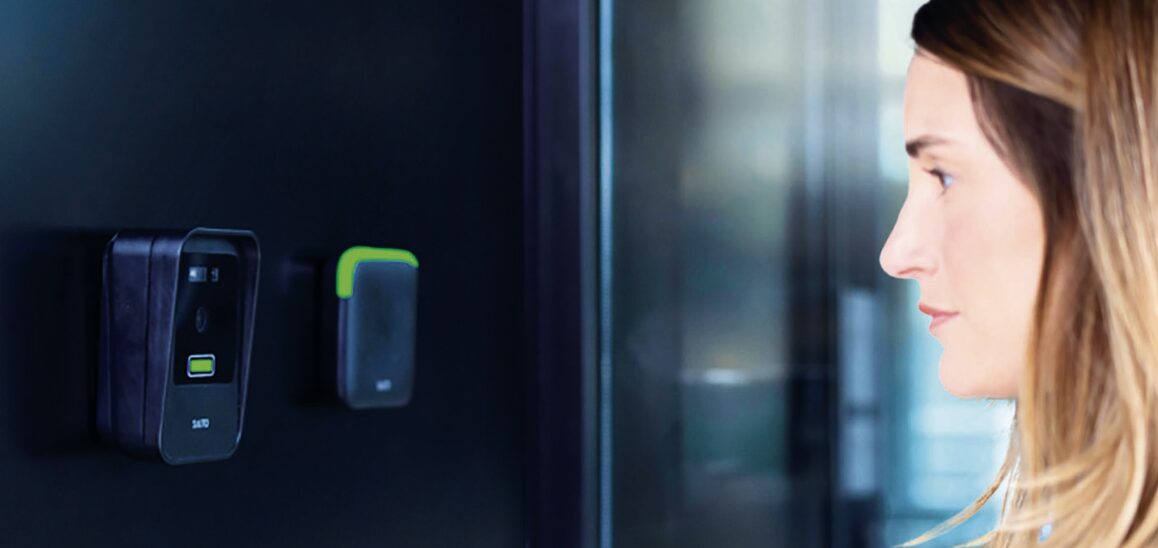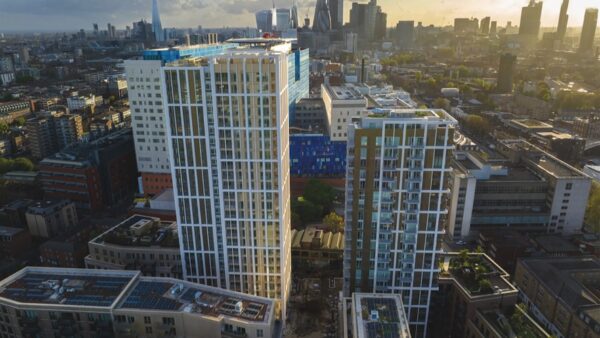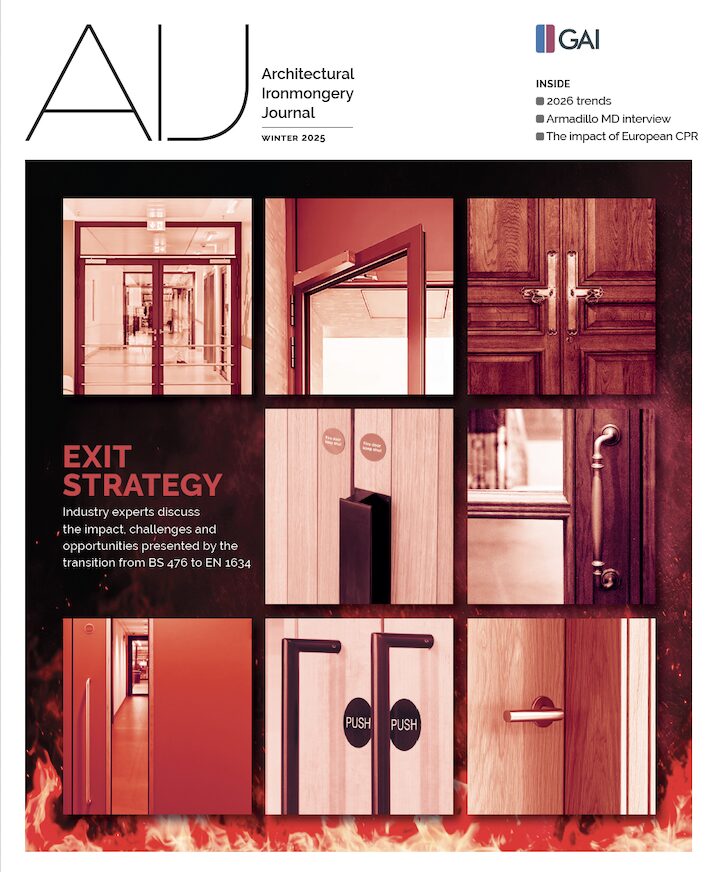Access control innovations are moving fast. What can we expect in the near future?

In February Salto launched Salto Orion – the first single-sourced face recognition access control solution on the market. Users gain access through a genuinely unique access credential – their face. This eliminates the need for physical keys or keycards; the user simply walks up to the access point, looks at the Orion-C terminal, and the door unlocks. Access is granted or denied in under a second, using a clear red or green LED light to display the status. It is also completely contactless, and no special positioning of the user’s face is necessary.
The advantages of this technology are clear for both user and building owner: it both streamlines the access process and enhances security by removing the risk of lost or stolen credentials entirely.
The use of identity authentication technology has risen rapidly in recent years. Other biometric credentials include fingerprints, voice patterns, iris scanning, facial recognition and even DNA. In a report published by market research company Technavio, the Biometric Access Control Systems Market Size is predicted to grow by $4.38 billion between 2023 and 2028.
Anyone with an iPhone or an Alexa will already be familiar with using voice, fingerprints or face and although these biometrics have been around for a while in access control, integration with security systems has been limited. In the past, it was much too expensive and inaccurate, and there were concerns around privacy. But as face scanning technology improves in quality, and prices fall, it’s become far more common. And with both 3D face recognition and fingerprint scanning now commonplace in smartphones, concerns about privacy are much less of an issue for users.
But biometrics is only one way that technology is redefining how people access spaces.
The future is mobile
According to Pip Courcoux, technical and product director at ASSA ABLOY, the future of access control lies with mobile phones. “A mobile phone is more powerful than even the best access control controller that’s on the market today,” he says. And The Chris Lewis Group, a bespoke fire and security system installer, offers this advice: “If you’re buying a new physical access control system, you should make sure it either supports mobile devices now, or in the future.”
According to SJA, the mobile access control credentials market is set to reach over $750 million in revenue by 2028, up from only $295 million in 2022.
Instead of a key card or key fob, which is costly, slower to set up, and easily lost, users download security credentials directly to their smartphone. A mobile-capable reader will check these credentials using a Bluetooth, Wi-Fi, mobile, or NFC connection. To gain access, you simply take your phone and wave it in front of a reader. In some cases the reader will detect the phone credentials in your pocket. So far, so nothing new. But with the ubiquity of smartphones what happens next will be that, as Courcoux puts it “people become the network”.
He explains: “Every time a phone comes within range of a reader and the identity of that phone can be linked back to a person you can track them around a building. That we can do today, but it is currently limited by the lack of perfect network coverage. When we get to the point where we have perfect resilient coverage why would anybody put in their own network, their own wireless routers into a building, if there was already 5g Network coverage from one of the providers?
“When we sell an access control system today we sell a boatload of infrastructure to install all over the building. But a mobile phone is more powerful than even the best access control controller that’s on the market today,” says Courcoux. “If you are using cloud technologies and secure communications then you don’t have to have your own networks. You will rent space from BT or Vodafone and then the people walking around with their phones become your edge device. In access control systems today you have a network of controllers, so for every door you have a two door controller or 12 door controller, in wireless access control you have proprietary wireless hubs. But with phones, everyone has got one and decisions can be made instantly and locally.”
It’s a huge cost saving for building owners. Users upgrade their phones and operating system every three years which means there’s no longer a need to replace control infrastructure.
SMART ACCESS TECH AT A GLANCE: examples of tech shaping the way we interact with buildings
AI-Powered Access Control
- Alcatraz AI Rock – Uses facial authentication and AI-driven anomaly detection to allow or deny access without requiring physical contact.
- Hikvision MinMoe – A touchless access system that combines facial recognition with temperature screening (useful for workplaces and healthcare facilities).
Biometric Access Systems
- IDEMIA MorphoWave – A contactless fingerprint scanner that works with a simple hand wave, already in use at high-security corporate offices.
- Apple Wallet Key Integration –
Many hotels now allow guests to use their iPhones/Apple Watches as digital room keys via biometrics.
Mobile & Cloud-Based Access
- SALTO KS (Keys as a Service) –
A cloud-based smart lock system used in co-working spaces and residential buildings, allowing remote management and mobile access. - Latch Smart Locks – Common in
smart apartments, enabling residents to unlock doors via an app and grant access remotely.
IoT-Enabled Smart Locks & Sensors
- Schlage Encode Plus – A Wi-Fi-enabled smart deadbolt that works
with Apple Home Key, allowing tap-to-enter access via Apple devices. - Kisi – An IoT-based access system that lets businesses manage access remotely and track door usage in real time.
Blockchain for Access Logs
- HYPR Decentralised Authentication – Uses blockchain-like technology to eliminate centralised password databases, enhancing security for corporate access systems.
- Telos Blockchain Smart Locks – Being tested in smart rental properties
to ensure secure, tamper-proof access control records.
5G & Edge Computing in Access Control
- Verkada Access Control – Uses edge-based AI to process entry requests faster and integrate with security cameras in smart buildings.
- Johnson Controls OpenBlue – A building management platform that leverages 5G and AI for real-time security monitoring and predictive access control.
Smart Spaces is an example of this already in action. A cutting edge app, it enables users and building control to control their environment and offer secure and fully hands-free access all from a mobile.
To work fully, this mobiles-as-network system also needs a standardised mobile credential (go Google Alira), a protocol between access readers and user devices, so that it’s easier to integrate irrespective of whether it’s for iOS or Android. This makes life much easier for manufacturers of readers.
Next up is robotic process automation (RPA) which Courcoux predicts to be huge in 10 years. RPA – Robotic Process Automation – is a technology that employs software bots to automate tasks by replicating human actions, thus reducing the time and cost associated with manual labor. Added to this is an Application Programming Interface (API), a set of protocols and definitions that enable different computer applications to communicate with each other.
RPA tools already exist in programmes like Microsoft Power Automate and If This, Then That. “Essentially they are workflow engines and in building systems this might translate as “if someone rings my doorbell it flashes the lights,” Courcoux explains. “Two different products from two different providers but I use an RPA tool to make that connection happen.”
What does that look like in daily life? If a person has a permit to drive forklift truck but their permit expires then the system will rescind their access control permissions, preventing them entering the warehouse. “The access control provider hasn’t had to build a competency management module – you just linked the two things together as you already have the competency management data somewhere else,” explains Courcoux.
What this all means for the longer term is that what we currently understand by the phrase ‘access control system’ will cease to exist and while there will always be a lock the system running behind it will be replaced by a phone, a 5G network and RPA tools.”
Clouding over
Cloud based access control systems are another invisible force behind how access control is being revolutionised.
Cloud computing has completely revolutionised how we think about storing, managing, and processing data. We are all familiar with our photos and videos from our smartphones no longer needing to be stored on a computer, or portable hard drive and cloud server storage has had the same impact on access control. Data is no longer stored on-site with no bulky and expensive hardware. Gone too is the need to maintain, and upgrade this infrastruture. With no need for physical servers, controllers are plug-and-play: all you need is internet access. Access privileges are easily managed and updates automatically downloaded and installed constantly. No fear of failure of system, not limited by size as it’s easily scalable and you link easily with other security solutions, (See APIs above).
Rage against the machine?
Not surprisingly where the real revolution in smart buildings lies is with artificial intelligence (AI) and machine learning (ML). We now have systems that can analyse vast amounts of data, identify patterns, predict potential threats and optimise access policies rapidly.
AI can identify unusual behaviour patterns, like multiple unauthorised access attempts or suspicious activity, and flag them to security teams. When paired with CCTV systems for visual verification, AI can improve accuracy. With this technology, people can be correctly identified, even in low light, or with their faces partially covered. As AI and ML continue to advance, their integration into access control systems will become even more sophisticated.

Life on the Edge
Dutch smart-office pioneer Edge will be opening its first premises in London next year. Designed by architects Pilbrow & Partners it has ambitions to be the most sustainable office tower in London. Through its design and use of technology it marks a radical departure from that of a traditional London office building. Alongside sustainability and wellbeing, smart technology is the third pillar of the developer’s design philosophy. It will use the Internet-of-things to connect everything and everyone in the building. Real-time data from the thousands of sensors enables air quality, occupancy and energy efficiency to be closely monitored and adjusted.
This also extends to AI-powered access control systems. These systems employ facial recognition and behaviour-based authentication to ensure secure and efficient entry for occupants. The integration of AI allows for real-time monitoring and anomaly detection, enhancing overall security.
The smartphone will be the workers’ passport to Edge London Bridge. An app will enable them to personalise their workplace and customise the lighting and temperature. Over time, it is hoped that the smart technology will provide information that will be able to measure productivity improvements and benefits. Deloitte, when it moved to the new Edge Amsterdam, used this technology and found that sick leave and absenteeism went down, and staff retention went up.
An online quiz based on this feature is available on the GAI Learning Hub. Completion of the quiz is worth one CPD point towards Registered Professional Status. learninghub.gai.org.uk/totara/dashboard/index.php
The Specifiers Guide to Access Control and The Specifiers Guide to the Internet
of Things are available at gai.org.uk/specifier








